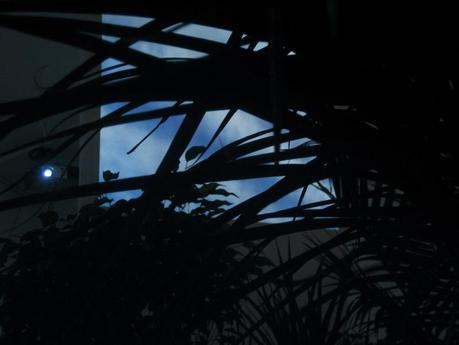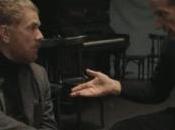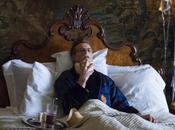Plant TV
by Adam Gopnik, March 15, 2010
 Jonathon Keats—a San Francisco-based experimental philosopher who has, over the years, sold real estate in the extra dimensions of space-time proposed by string theory (he sold a hundred and seventy-two extra-dimensional lots in the Bay Area in a single day); made an attempt to genetically engineer God (God turns out to be related to the cyanobacterium); and copyrighted his own mind (in order to get a seventy-year post-life extension)—came to New York a couple of weeks ago to exhibit his latest thought experiment: television for plants. In a landscape of conceptual art most often known for pure puzzlement or pallid preaching, Keats is a poet of ideas, whose work always rests on a solid basis of scientific research and resolves in a startling, semi-serious image.The television-for-plants project has been installed in a fifth-floor space at the AC Institute, on West Twenty-seventh Street, in Chelsea. A collection of houseplants—the kind of rubber plants that your great-aunt watered and tended—rest on the floor, thoughtfully regarding a video on a screen above their heads. The video shows, on a six-and-a-half-minute loop, a beautiful Italian sky, which passes into night, complete with romantic Italian moon, and then returns to dawn. Visitors are urged to bring their own plants to watch the show.Jon Keats—that really is his given name—has mastered an expression so sincere that one begins to suspect him of irony. With that look embossed on his face, he explained to a visitor, the other day, that television for plants was an extension of an earlier project to make pornography for plants. “Pornography is where every filmmaker starts out,” he said evenly, “and in my case I was making pornography for plants by filming bees pollinating flowers.” There were two different shows of plant porn: one in Chico, California, for about a hundred rhododendrons, and one at Montana State University, for as many zinnias. “I knew that the act of pollination was the most titillating experience for plants,” Keats said. “So I spent a couple of days on the ground, seeing how light and shadow were experienced from their perspective. Once I had a very stark black-and-white image—sun up high, bees flying by. I let it run for a month, and let the plants experience vicarious sex. And let people stand at the periphery and giggle nervously.”
Jonathon Keats—a San Francisco-based experimental philosopher who has, over the years, sold real estate in the extra dimensions of space-time proposed by string theory (he sold a hundred and seventy-two extra-dimensional lots in the Bay Area in a single day); made an attempt to genetically engineer God (God turns out to be related to the cyanobacterium); and copyrighted his own mind (in order to get a seventy-year post-life extension)—came to New York a couple of weeks ago to exhibit his latest thought experiment: television for plants. In a landscape of conceptual art most often known for pure puzzlement or pallid preaching, Keats is a poet of ideas, whose work always rests on a solid basis of scientific research and resolves in a startling, semi-serious image.The television-for-plants project has been installed in a fifth-floor space at the AC Institute, on West Twenty-seventh Street, in Chelsea. A collection of houseplants—the kind of rubber plants that your great-aunt watered and tended—rest on the floor, thoughtfully regarding a video on a screen above their heads. The video shows, on a six-and-a-half-minute loop, a beautiful Italian sky, which passes into night, complete with romantic Italian moon, and then returns to dawn. Visitors are urged to bring their own plants to watch the show.Jon Keats—that really is his given name—has mastered an expression so sincere that one begins to suspect him of irony. With that look embossed on his face, he explained to a visitor, the other day, that television for plants was an extension of an earlier project to make pornography for plants. “Pornography is where every filmmaker starts out,” he said evenly, “and in my case I was making pornography for plants by filming bees pollinating flowers.” There were two different shows of plant porn: one in Chico, California, for about a hundred rhododendrons, and one at Montana State University, for as many zinnias. “I knew that the act of pollination was the most titillating experience for plants,” Keats said. “So I spent a couple of days on the ground, seeing how light and shadow were experienced from their perspective. Once I had a very stark black-and-white image—sun up high, bees flying by. I let it run for a month, and let the plants experience vicarious sex. And let people stand at the periphery and giggle nervously.” 
He continued, “So I decided to go on to other plant subjects, and to me the subject that would be most interesting to plants is travel. Plants don’t get to go anywhere. They’re rooted in the ground. But if you’re a plant you’re not going to get excited about the Eiffel Tower—instead, you’re going to be excited about the sky.” Keats filmed an Italian sky over two months. “We know that plants experience light very differently in different parts of the spectrum,” he said. “Both NASA and the Soviet-era agronomy schools studied this problem closely, because of their interest in how to grow plants in space or indoors in Siberia. I wanted to think of it not as manipulation of plants but as entertainment and edification for them. I knew that they could experience color, and—knowing that where you are in the world will have a great effect on what color relationships you experience—I wanted to bring that whole specific set of color experiences to plants, which would otherwise never be able to get to Italy.” (Keats also included jet trails in the video, because “I didn’t want to be too pastoral. I didn’t want to idealize Italy for the plants. These are travel documentaries, not advertisements to get plants to travel.”)The plants, soberly observing their entertainment, seem wholesomely unmanipulated. But Keats is also aware of the small didactic point lurking in the project. “What I’m always doing is trying to pose thought experiments in the old-fashioned philosophical way,” he said, “imagining from a radically different perspective circumstances that are very familiar to us, in order to make them unfamiliar and force us to start to pull them apart. So if your children are supposedly vegetating in front of the television when they watch it for hours, what happens when you show television to vegetables? I don’t have the answers, or I wouldn’t make the work.” ♦
Jonathon has already appeared on the blog here:
- Interview on NBC about the book Virtual Words (and more)
- Documentary on Discovery Channel about his Textbooks for Bacteria
- The Photosynthetic Restaurant at the Crocker Art Museum




